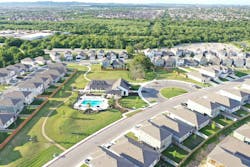Built to Rent Is Booming, But Operational Challenges Loom for This Housing Sector
As a housing solution, single-family built-to-rent (B2R) is gaining serious momentum across the country. Major players, including large private equity firms, investment funds, and public home builders, are all entering the space with lofty goals.
Demand and activity in single-family B2R is surging, especially in secondary markets. With so much capital flowing into the business, key issues are emerging that affect its long-term viability. That’s because a large portion of the newer players in the space are heavily focused on short-term return on investment (ROI), with business plans leading them to deliver new communities in undesirable locations and some taking on roles beyond their skill set.
The fact is, B2R communities destined for long-term success are optimally located, well-designed, and consistently maintained to attract quality tenants and ensure long-term asset value. They are also operated and managed on site like a well-oiled multifamily community. And yet just a small number of the newer single-family B2R developers are creating communities that meet these key criteria.
RELATED
- Single-Family Rentals Are Taking Over the Housing Market
- Are You Ready for Build to Rent?
- Single-Family Rent Growth Hits 35-Year High
Capital Is Flowing Into Built-to-Rent Development
Institutional capital has been active in single-family rentals since the global financial crisis 15 years ago, when large investors began purchasing, aggregating, and leasing distressed, foreclosed homes.
But until recently, most investors failed to recognize the legitimacy of another major single-family rental business model: newly built rental homes set within contiguous master planned communities. Now billions of dollars are being spent pursuing those B2R development opportunities.
There are benefits to the private equity cohort finally buying into this B2R community model. However, the volume of capital being raised is problematic because actual deployment of the opportunity is challenging, at best. As a result, some of these large capital sources have begun to step into roles completely outside of their wheelhouse.
Private Equity Firms Go It Alone Developing and Managing B2R Communities
Blue-chip private equity firms are now forgoing traditional operating partner relationships and developing and managing B2R communities on their own. Taking on this new role positions them as competitors to industry veterans that, in the past, invariably educated these same capital providers when they were seeking equity partners to capitalize new communities.
Private equity firms have never been developers or operators of the communities they finance, so we must ask: By taking on those roles, are they able to fulfill their primary duty as a fiduciary? Are pension funds, endowments, and institutional investors comfortable with their investment managers wearing the developer and/or operational hat?
Private equity firms are not experts at those aspects of the business, and even if they hire a team for the job, it’s still risky. There’s also a strong likelihood that because of the sheer volume of capital being raised today for B2R, many will never build all of the communities they seek to develop, despite having raised the money to do so.
RELATED
- Design Ideas for Single-Family Built-to-Rent Homes
- Year-Over-Year Rents for Single-Family Homes Are Rising Quickly
- High Income Millennials Are Becoming Lifestyle Renters Rather Than Homeowners
Big Builders Jump Into Single-Family B2R
Some of the country’s largest production home builders have also joined in the single-family B2R frenzy. The appeal undoubtedly comes from the ability to sell numerous newly built homes in a single transaction to an operator or investor (as opposed to selling one house at a time to consumers within a for-sale community), thus generating quick ROI and being a boon to revenue and earnings.
In addition to a dramatically decreased sales cycle, builders also are attracted to the opportunity to sell to an operator that is less influenced by interest rates and the other details that concern individual homebuyers.
In many ways, it makes sense for traditional for-sale builders to be involved in B2R. But because their main goal is instant profit, they likely aren’t building with as much concern for the longevity of the home or for the community design and how they will be amenitized, leased, and maintained over time. They are often selling their homes to investment funds that are no more adept at driving long-term value. And in many cases, fewer than 50 homes are sold in a given transaction, which makes long-term on-site management financially unfeasible, to the detriment of the maintenance, quality, aesthetics, and marketability of the homes and the community over time.
Location, Location, Location—It Matters Just as Much With B2R Communities
As is true with all real estate, location matters. Yet, increasingly, B2R communities are being developed in places that aren’t proximate to major employment centers, services, or attractions. In the long run, this tendency to build on the outskirts will weigh heavily on whether these communities succeed or not, as they likely experience a steady decline attracting quality renters and top-of-the-market rents, eroding their asset value.
The cost of land today is undoubtedly tied to this dynamic, as entities focused on short-term ROI are unable or unwilling to pay higher prices for land developed for rental housing.
Additionally, the volume of capital raised for B2R investment, which must be deployed quickly, is leading some to settle for or to choose poor locations—a short-term view.
Unfortunately, the long-term consequences of bad community locations can never be reversed. By contrast, urban-adjacent, infill locations near grocery-anchored retail and employment centers are optimal. While pricey, the value of these sites and communities will hold over time.
The Gold Standard in Built-to-Rent
Today, there are relatively few players delivering contiguous, master planned B2R communities, and fewer still operating a vertically integrated business, building and maintaining the communities themselves.
Arguably, the best model for these communities—what we’ve trademarked as “Built-for-Rent”—is one that is functionally integrated, where communities are well-located, offer superb amenity packages, are professionally managed on site, and, ultimately, are treated and operated like a traditional apartment business. As an industry, we must strive to follow this model toward lasting community value.

